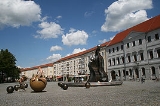
Dessau
Encyclopedia
Dessau is a town in Germany
on the junction of the rivers Mulde
and Elbe
, in the Bundesland
(Federal State) of Saxony-Anhalt
. Since 1 July 2007, it is part of the merged town Dessau-Roßlau
. Population of Dessau proper: 77,973 (June 2006).
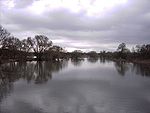 Dessau is situated on a floodplain where the Mulde
Dessau is situated on a floodplain where the Mulde
flows into the Elbe
. This causes yearly floods. The worst flood
took place in the year 2002, when the Waldersee district was nearly completely flooded. The south of Dessau touches a well-wooded area called Mosigkauer Heide. The highest elevation is a 110m high former rubbish dump called Scherbelberg in the southwest of Dessau. Dessau is surrounded by numerous parks and palaces that ranks Dessau as one of the greenest towns in Germany.
was founded. Dessau became the capital of this state within the Holy Roman Empire
. Anhalt was dissolved In 1603 it was split into four – later five – Anhalts, Dessau becoming the capital of the mini-state of Anhalt-Dessau
until 1918. In 1863 two of the noble line died out, and became reunited.
Dessau is famous for its college of architecture Bauhaus
. It moved here in 1925 after it had been forced to close in Weimar. Many famous artists were lecturers in Dessau in the following years, among them Walter Gropius
, Paul Klee
and Wassily Kandinsky
. The Nazis forced the closure of the Bauhaus in 1931, and it was not reopened until 1986.
The city was almost completely destroyed by Allied air raids in World War II
on March 7, 1945, six weeks before American troops occupied the town. Afterwards it was rebuilt with typical GDR concrete slab architecture (Plattenbau
) and became a major industrial centre of East Germany. Since German reunification
in 1990 many historic buildings have been restored.
The composer Kurt Weill
was born in Dessau. Since 1993 the city has hosted an annual Kurt Weill Festival. Dessau was also the birthplace of the philosopher Moses Mendelssohn
(in 1729), and Leopold I, Prince of Anhalt-Dessau
(der alte Dessauer), a lauded field marshal for the Kingdom of Prussia
.
Since January 7, 2005, Dessau has gained notoriety for the mysterious death of asylum seeker Oury Jalloh from Sierra Leone in his cell at a Dessau police station. According to local police, Jalloh, who was drunk and had been tied to his bed, set his own mattress on fire, causing his own death as he burned alive. A number of contradictions and inconsistencies as well as the disappearance of key evidence such as video tapes have led to allegations that the police and maybe even the local court may have been involved in Jalloh's death and subsequent cover-up efforts. A local court acquitted officers in 2008. In 2010, however, a higher federal court declared that ruling null and void, and ordered a new investigation and trial be launched.

architecture in Dessau, some of them included in the UNESCO
World Heritage. The Bauhaus
College itself was constructed after drafts by Walter Gropius
.
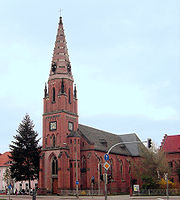
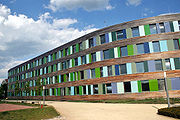

way system with three lines and several buses with numerous lines. The public transport is organized by a company named “DVG”, every year they transport around 6 million people.
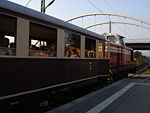
, Berlin
, Leipzig
, Halle
, Bitterfeld
and Lutherstadt Wittenberg
. The line from Berlin
was opened on 1 September 1840. The Dessau-Bitterfeld line (opened on 17 August 1857) was electrified in 1911, the first fully electrified long-distance railway in Germany. Dessau was part of the InterCity
long distance network until the year 2002. Regional trains also stop at the stations Dessau-Süd, Dessau-Alten, Dessau-Mosigkau and Rodleben. The Dessau-Wörlitzer-Eisenbahn (railway) connects Dessau to Wörlitz
, a town situated 15 km to the east, and the Wörlitzer Park. Starting point of this railway is the main station. This train also stops at the stations Dessau-Waldersee and Dessau-Adria.
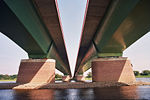 In 1938 the autobahn A9 (Munich-Berlin) was built southeast of the town area. The two exits to Dessau on the A9 are called "Dessau-Ost" and "Dessau-Süd". Dessau is also crossed by the "Bundesstrassen
In 1938 the autobahn A9 (Munich-Berlin) was built southeast of the town area. The two exits to Dessau on the A9 are called "Dessau-Ost" and "Dessau-Süd". Dessau is also crossed by the "Bundesstrassen
" (federal roads) B 184 and B 185.
Technical Museum is situated in the neighbourhood (directly east) of the airfield, which has the eastern end of the modern runway almost directly abutting the historical World War II Junkers factory airstrip's western end.
is very appropriate for biking. The bike roads have a length of about 146 km and lead to all the parks and sights.
Next to the traditional sports, Dessau has active sport clubs in the following disciplines: aikido, badminton, basketball, canoeing, chess, climbing, cycling, dancing, fishing, horse riding, karate, judo, jiu-jitsu, motorboat, rowing, speedskating, sailing, skittles, skydiving, squash, swimming, table tennis, water polo, wrestling and a few more.
this committee is elected free. And since 1994 it's called "Stadtrat" (Town Council). The Mayor is directly elected by the people since 1994.
, France
, since 1959 Klagenfurt
, Austria
, since 1971 Ludwigshafen, Rhineland-Palatinate
, since 1988 Gliwice
, Poland
, since 1992 Ibbenbüren
, North Rhine-Westphalia
Roudnice nad Labem
, Czech Republic
Germany
Germany , officially the Federal Republic of Germany , is a federal parliamentary republic in Europe. The country consists of 16 states while the capital and largest city is Berlin. Germany covers an area of 357,021 km2 and has a largely temperate seasonal climate...
on the junction of the rivers Mulde
Mulde
The Mulde is a river in Saxony and Saxony-Anhalt, Germany. It is a left tributary of the Elbe and 124 km in length.The river is formed by the confluence, near Colditz, of the Zwickauer Mulde and the Freiberger Mulde , both rising from the Ore Mountains...
and Elbe
Elbe
The Elbe is one of the major rivers of Central Europe. It rises in the Krkonoše Mountains of the northwestern Czech Republic before traversing much of Bohemia , then Germany and flowing into the North Sea at Cuxhaven, 110 km northwest of Hamburg...
, in the Bundesland
States of Germany
Germany is made up of sixteen which are partly sovereign constituent states of the Federal Republic of Germany. Land literally translates as "country", and constitutionally speaking, they are constituent countries...
(Federal State) of Saxony-Anhalt
Saxony-Anhalt
Saxony-Anhalt is a landlocked state of Germany. Its capital is Magdeburg and it is surrounded by the German states of Lower Saxony, Brandenburg, Saxony, and Thuringia.Saxony-Anhalt covers an area of...
. Since 1 July 2007, it is part of the merged town Dessau-Roßlau
Dessau-Roßlau
' is an independent city and urban district in the German state of Saxony-Anhalt. It is situated at the confluence of the rivers Elbe and Mulde. The town was formed by merger of the independent city of Dessau with the town of Roßlau in the course of the Kreisreform Sachsen-Anhalt on 1 July 2007...
. Population of Dessau proper: 77,973 (June 2006).
Geography

Mulde
The Mulde is a river in Saxony and Saxony-Anhalt, Germany. It is a left tributary of the Elbe and 124 km in length.The river is formed by the confluence, near Colditz, of the Zwickauer Mulde and the Freiberger Mulde , both rising from the Ore Mountains...
flows into the Elbe
Elbe
The Elbe is one of the major rivers of Central Europe. It rises in the Krkonoše Mountains of the northwestern Czech Republic before traversing much of Bohemia , then Germany and flowing into the North Sea at Cuxhaven, 110 km northwest of Hamburg...
. This causes yearly floods. The worst flood
Flood
A flood is an overflow of an expanse of water that submerges land. The EU Floods directive defines a flood as a temporary covering by water of land not normally covered by water...
took place in the year 2002, when the Waldersee district was nearly completely flooded. The south of Dessau touches a well-wooded area called Mosigkauer Heide. The highest elevation is a 110m high former rubbish dump called Scherbelberg in the southwest of Dessau. Dessau is surrounded by numerous parks and palaces that ranks Dessau as one of the greenest towns in Germany.
History
Dessau was first mentioned in 1213. It became an important centre in 1570, when the principality of AnhaltAnhalt
Anhalt was a sovereign county in Germany, located between the Harz Mountains and the river Elbe in Middle Germany. It now forms part of the state of Saxony-Anhalt.- Dukes of Anhalt :...
was founded. Dessau became the capital of this state within the Holy Roman Empire
Holy Roman Empire
The Holy Roman Empire was a realm that existed from 962 to 1806 in Central Europe.It was ruled by the Holy Roman Emperor. Its character changed during the Middle Ages and the Early Modern period, when the power of the emperor gradually weakened in favour of the princes...
. Anhalt was dissolved In 1603 it was split into four – later five – Anhalts, Dessau becoming the capital of the mini-state of Anhalt-Dessau
Anhalt-Dessau
Anhalt-Dessau was a principality and later a duchy located in Germany. It was created in 1396 following the partition of the Principality of Anhalt-Zerbst. The capital of the state was Dessau. Anhalt-Dessau experienced a number of partitions throughout its existence with Anhalt-Köthen being...
until 1918. In 1863 two of the noble line died out, and became reunited.
Dessau is famous for its college of architecture Bauhaus
Bauhaus
', commonly known simply as Bauhaus, was a school in Germany that combined crafts and the fine arts, and was famous for the approach to design that it publicized and taught. It operated from 1919 to 1933. At that time the German term stood for "School of Building".The Bauhaus school was founded by...
. It moved here in 1925 after it had been forced to close in Weimar. Many famous artists were lecturers in Dessau in the following years, among them Walter Gropius
Walter Gropius
Walter Adolph Georg Gropius was a German architect and founder of the Bauhaus School who, along with Ludwig Mies van der Rohe and Le Corbusier, is widely regarded as one of the pioneering masters of modern architecture....
, Paul Klee
Paul Klee
Paul Klee was born in Münchenbuchsee, Switzerland, and is considered both a German and a Swiss painter. His highly individual style was influenced by movements in art that included expressionism, cubism, and surrealism. He was, as well, a student of orientalism...
and Wassily Kandinsky
Wassily Kandinsky
Wassily Wassilyevich Kandinsky was an influential Russian painter and art theorist. He is credited with painting the first purely-abstract works. Born in Moscow, Kandinsky spent his childhood in Odessa. He enrolled at the University of Moscow, studying law and economics...
. The Nazis forced the closure of the Bauhaus in 1931, and it was not reopened until 1986.
The city was almost completely destroyed by Allied air raids in World War II
World War II
World War II, or the Second World War , was a global conflict lasting from 1939 to 1945, involving most of the world's nations—including all of the great powers—eventually forming two opposing military alliances: the Allies and the Axis...
on March 7, 1945, six weeks before American troops occupied the town. Afterwards it was rebuilt with typical GDR concrete slab architecture (Plattenbau
Plattenbau
Plattenbau is the German word for a building whose structure is constructed of large, prefabricated concrete slabs. The word is a compound of Platte and Bau...
) and became a major industrial centre of East Germany. Since German reunification
German reunification
German reunification was the process in 1990 in which the German Democratic Republic joined the Federal Republic of Germany , and when Berlin reunited into a single city, as provided by its then Grundgesetz constitution Article 23. The start of this process is commonly referred by Germans as die...
in 1990 many historic buildings have been restored.
The composer Kurt Weill
Kurt Weill
Kurt Julian Weill was a German-Jewish composer, active from the 1920s, and in his later years in the United States. He was a leading composer for the stage who was best known for his fruitful collaborations with Bertolt Brecht...
was born in Dessau. Since 1993 the city has hosted an annual Kurt Weill Festival. Dessau was also the birthplace of the philosopher Moses Mendelssohn
Moses Mendelssohn
Moses Mendelssohn was a German Jewish philosopher to whose ideas the renaissance of European Jews, Haskalah is indebted...
(in 1729), and Leopold I, Prince of Anhalt-Dessau
Leopold I, Prince of Anhalt-Dessau
Leopold I, Prince of Anhalt-Dessau was a German prince of the House of Ascania and ruler of the principality of Anhalt-Dessau. He was also a Generalfeldmarschall in the Prussian army...
(der alte Dessauer), a lauded field marshal for the Kingdom of Prussia
Kingdom of Prussia
The Kingdom of Prussia was a German kingdom from 1701 to 1918. Until the defeat of Germany in World War I, it comprised almost two-thirds of the area of the German Empire...
.
Since January 7, 2005, Dessau has gained notoriety for the mysterious death of asylum seeker Oury Jalloh from Sierra Leone in his cell at a Dessau police station. According to local police, Jalloh, who was drunk and had been tied to his bed, set his own mattress on fire, causing his own death as he burned alive. A number of contradictions and inconsistencies as well as the disappearance of key evidence such as video tapes have led to allegations that the police and maybe even the local court may have been involved in Jalloh's death and subsequent cover-up efforts. A local court acquitted officers in 2008. In 2010, however, a higher federal court declared that ruling null and void, and ordered a new investigation and trial be launched.
Castles and gardens
- Dessau-Wörlitzer Gartenreich with Landscape Garden Groß Kühnau, OranienbaumOranienbaumOranienbaum may refer to:Germany:* Oranienbaum, Germany, a town in Saxony-Anhalt, Germany* Oranienbaum-WörlitzRussia:* Oranienbaum, Russia , a Russian royal residence* Lomonosov , the former name of the adjacent town...
, Sieglitzer Berg, Leiner Berg, Wörlitzer Park and numerous Monuments like the Drehberg (recorded in the UNESCOUNESCOThe United Nations Educational, Scientific and Cultural Organization is a specialized agency of the United Nations...
World Heritage) - Middle ElbeElbeThe Elbe is one of the major rivers of Central Europe. It rises in the Krkonoše Mountains of the northwestern Czech Republic before traversing much of Bohemia , then Germany and flowing into the North Sea at Cuxhaven, 110 km northwest of Hamburg...
Biosphere Reserve (protected by UNESCO) - Zoo at Mausoleumspark
- Wallwitzburg
- Rondell
- remains of the City Castle (Johannbau)
- Georgium Palace and Park
- Kühnau Palace and Park
- Mosigkau Palace and Park
- Luisium Palace and Park

The Bauhaus
There are several examples of BauhausBauhaus
', commonly known simply as Bauhaus, was a school in Germany that combined crafts and the fine arts, and was famous for the approach to design that it publicized and taught. It operated from 1919 to 1933. At that time the German term stood for "School of Building".The Bauhaus school was founded by...
architecture in Dessau, some of them included in the UNESCO
UNESCO
The United Nations Educational, Scientific and Cultural Organization is a specialized agency of the United Nations...
World Heritage. The Bauhaus
Bauhaus
', commonly known simply as Bauhaus, was a school in Germany that combined crafts and the fine arts, and was famous for the approach to design that it publicized and taught. It operated from 1919 to 1933. At that time the German term stood for "School of Building".The Bauhaus school was founded by...
College itself was constructed after drafts by Walter Gropius
Walter Gropius
Walter Adolph Georg Gropius was a German architect and founder of the Bauhaus School who, along with Ludwig Mies van der Rohe and Le Corbusier, is widely regarded as one of the pioneering masters of modern architecture....
.
- BauhausBauhaus', commonly known simply as Bauhaus, was a school in Germany that combined crafts and the fine arts, and was famous for the approach to design that it publicized and taught. It operated from 1919 to 1933. At that time the German term stood for "School of Building".The Bauhaus school was founded by...
Dessau Museum, with audiovisual guidance - Masters' Houses
- Feininger House (Kurt WeillKurt WeillKurt Julian Weill was a German-Jewish composer, active from the 1920s, and in his later years in the United States. He was a leading composer for the stage who was best known for his fruitful collaborations with Bertolt Brecht...
Centre) - Muche-Schlemmer House
- KleeKleeKlee , named after Paul Klee, is a German pop-band from Cologne.-Lineup 2002-2010 :* Suzie Kerstgens * Tom Deininger * Sten Servaes -Lineup 2010-present :...
-Kandinsky House - GropiusWalter GropiusWalter Adolph Georg Gropius was a German architect and founder of the Bauhaus School who, along with Ludwig Mies van der Rohe and Le Corbusier, is widely regarded as one of the pioneering masters of modern architecture....
House (destroyed), now used for ticket sales, as a café and as a book-shop
- Feininger House (Kurt Weill
- Dessau-Törten Estate with co-op Building and House of Steel, Laubenganghouses and Fieger House
- Grain House, constructed by Carl Fieger in 1930 as a restaurant, still in operation
- Employment Office

Churches
- St. Mary's Church
- St. John's Church
- Georgenkirche
- Petruskirche
- Auferstehungskirche
- Pauluskirche
- Christuskirche
- Propsteikirche St. Peter and Paul
- Dreieinigkeit
- St. Josef

Other sights
- Townhall, built in 1901
- The Palaces of Waldersee and Dietrich, today they are used as libraries
- General Post Office
- New Water Tower
- Umweltbundesamt (formerly Wörlitzer Bahnhof)
- Footbridge crossing the river MuldeMuldeThe Mulde is a river in Saxony and Saxony-Anhalt, Germany. It is a left tributary of the Elbe and 124 km in length.The river is formed by the confluence, near Colditz, of the Zwickauer Mulde and the Freiberger Mulde , both rising from the Ore Mountains...
Theatres and museums

- Anhalt Theatre including Gregor Seyffert & Compagnie
- City History Museum
- Anhalt Art Gallery at Georgium Palace with Park
- Mosigkau Palace Museum
- Luisium Castle Museum with Park
- OranienbaumOranienbaum, Germany' is a former town and a former municipality in the district of Wittenberg, in Saxony-Anhalt, Germany. Since 1 January 2011, it is part of the town Oranienbaum-Wörlitz...
Palace Museum with Park - Museum of Natural- and Prehistory
- Moses MendelssohnMoses MendelssohnMoses Mendelssohn was a German Jewish philosopher to whose ideas the renaissance of European Jews, Haskalah is indebted...
- Zentre - Hugo JunkersHugo JunkersHugo Junkers was an innovative German engineer, as his many patents in varied areas show...
Technical Museum - UCI Cinema Complex
- Kiez-Cinema (one of the smallest Cinemas in Germany)
Regional media
- Mitteldeutsche Zeitung (daily newspaperNewspaperA newspaper is a scheduled publication containing news of current events, informative articles, diverse features and advertising. It usually is printed on relatively inexpensive, low-grade paper such as newsprint. By 2007, there were 6580 daily newspapers in the world selling 395 million copies a...
, Monday-Saturday) - Wochenspiegel (free newspaper on Wednesday) and Supersonntag (free newspaper on Sunday)
- REGJO (quarterly Economy Journal for the Region of LeipzigLeipzigLeipzig Leipzig has always been a trade city, situated during the time of the Holy Roman Empire at the intersection of the Via Regia and Via Imperii, two important trade routes. At one time, Leipzig was one of the major European centres of learning and culture in fields such as music and publishing...
/HalleHalle, Saxony-AnhaltHalle is the largest city in the German state of Saxony-Anhalt. It is also called Halle an der Saale in order to distinguish it from the town of Halle in North Rhine-Westphalia...
) - leo (monthly, regional Event- and Culture Magazine)
- local Studios of the MDRMDRMDR or mdr may refer to:* "MDR" is abbreviation of Master Document Register.* "MDR" is abbreviation of "Mort de rire" in french .* Mammalian diving reflex* Mandar language* Marina del Rey, California...
and SAW (Radiostations) - local TV Stations: RAN 1 and Offener Kanal Dessau
Public transport
Dessau owns a tramTram
A tram is a passenger rail vehicle which runs on tracks along public urban streets and also sometimes on separate rights of way. It may also run between cities and/or towns , and/or partially grade separated even in the cities...
way system with three lines and several buses with numerous lines. The public transport is organized by a company named “DVG”, every year they transport around 6 million people.

Railway stations
Dessau Hauptbahnhof (main station) has connections to MagdeburgMagdeburg
Magdeburg , is the largest city and the capital city of the Bundesland of Saxony-Anhalt, Germany. Magdeburg is situated on the Elbe River and was one of the most important medieval cities of Europe....
, Berlin
Berlin
Berlin is the capital city of Germany and is one of the 16 states of Germany. With a population of 3.45 million people, Berlin is Germany's largest city. It is the second most populous city proper and the seventh most populous urban area in the European Union...
, Leipzig
Leipzig
Leipzig Leipzig has always been a trade city, situated during the time of the Holy Roman Empire at the intersection of the Via Regia and Via Imperii, two important trade routes. At one time, Leipzig was one of the major European centres of learning and culture in fields such as music and publishing...
, Halle
Halle, Saxony-Anhalt
Halle is the largest city in the German state of Saxony-Anhalt. It is also called Halle an der Saale in order to distinguish it from the town of Halle in North Rhine-Westphalia...
, Bitterfeld
Bitterfeld
Bitterfeld is a town in the district Anhalt-Bitterfeld, Saxony-Anhalt, Germany. Since 1 July 2007 it has been part of the town Bitterfeld-Wolfen. It is situated approx. 25 km south of Dessau, and 30 km northeast of Halle...
and Lutherstadt Wittenberg
Wittenberg
Wittenberg, officially Lutherstadt Wittenberg, is a city in Germany in the Bundesland Saxony-Anhalt, on the river Elbe. It has a population of about 50,000....
. The line from Berlin
Anhalt Railway
The Anhalt railway , most commonly referred to as the Berlin-Halle railway , is a twin-track, electrified main line found in the German city-state of Berlin, and the states of Brandenburg and Sachsen-Anhalt...
was opened on 1 September 1840. The Dessau-Bitterfeld line (opened on 17 August 1857) was electrified in 1911, the first fully electrified long-distance railway in Germany. Dessau was part of the InterCity
InterCity
InterCity is the classification applied to certain long-distance passenger train services in Europe...
long distance network until the year 2002. Regional trains also stop at the stations Dessau-Süd, Dessau-Alten, Dessau-Mosigkau and Rodleben. The Dessau-Wörlitzer-Eisenbahn (railway) connects Dessau to Wörlitz
Wörlitz
' is a town and a former municipality in the district of Wittenberg, in Saxony-Anhalt, Germany. Since 1 January 2011, it is part of the town Oranienbaum-Wörlitz. It is situated on the left bank of the Elbe, east of Dessau...
, a town situated 15 km to the east, and the Wörlitzer Park. Starting point of this railway is the main station. This train also stops at the stations Dessau-Waldersee and Dessau-Adria.
Roads

Bundesstraße
Bundesstraße , abbreviated B, is the denotation for German and Austrian national highways.-Germany:...
" (federal roads) B 184 and B 185.
The airfield
The airfield of Dessau is situated northwest of the town between the districts Kleinkühnau, Alten and Siedlung. A destination with a charter airplane is possible. The runway has a length of 1000m. The Hugo JunkersHugo Junkers
Hugo Junkers was an innovative German engineer, as his many patents in varied areas show...
Technical Museum is situated in the neighbourhood (directly east) of the airfield, which has the eastern end of the modern runway almost directly abutting the historical World War II Junkers factory airstrip's western end.
Water
Today the “Leopoldshafen” (harbour) is used for the annual international motorboat racings. The “Wallwitzhafen” is used as a private sportboat harbour and the “Elbehafen” near the Grain House is used for cruisers. The next harbour for goods is situated in Rosslau.Bikes
Dessau, with its flat landscape in the Saxon LowlandSaxon Lowland
The Saxon Lowland or Saxon Löss Fields refer to a natural region that lies mainly within the state of Saxony in central Germany. In addition, small areas of this region extend to the northwest and west into Saxony-Anhalt , to the southeast into Thuringia and to the northeast into Brandenburg...
is very appropriate for biking. The bike roads have a length of about 146 km and lead to all the parks and sights.
Sports
Sports like soccer, cycling, handball, volleyball, gymnastics, table tennis and tennis have a long tradition and are very popular in Dessau. The former soccer team "SG Waggonbau Dessau" won the GDR soccer cup in 1949. The handball team played in the GDR "Oberliga" and since 1990 they are playing in the 1st and 2nd "Bundesliga". Currently, Dessau has around 80 sport clubs with over 13,500 members.Next to the traditional sports, Dessau has active sport clubs in the following disciplines: aikido, badminton, basketball, canoeing, chess, climbing, cycling, dancing, fishing, horse riding, karate, judo, jiu-jitsu, motorboat, rowing, speedskating, sailing, skittles, skydiving, squash, swimming, table tennis, water polo, wrestling and a few more.
Facilities
- Numerous Sports Fields (more than 10)
- Skittle Alleys (6)
- Tennis Courts (3)
- Boathouses (3)
- Indoor Swimming Pools (2)
- Paul-Greifzu-Stadion (for 22.000 viewers)
- Speedskating Course
- Climbing Tower Zuckerturm
- Anhalt Arena Dessau (for 3.600 viewers)
- Airfield Dessau
- Rifle Range
Politics
The borough of Dessau is mentioned first in 1372. The Head of the Town called "Schultheiss" was constituted by the Earl. Together with a few assessors the "Schultheiss" formed the Town Council. As of 1372 the Town Council was divided in 2 agencies. As of 1600 in three agencies and as of 1785 again in two agencies. The "Schultheiss" of Dessau changed nearly every year until the Town Council Constitution was cancelled in 1832. Afterwards Dessau became a Town Council and a Town Delegation Constitution. Since 1852 the Head of the Town is called Mayor. During the National Socialism the Mayor was constituted by the party (NSDAP). After the 2nd World War the Soviets formed an Executiv Council with a Mayor. The Town Council Constitution was elected by the people. Since the German reunificationGerman reunification
German reunification was the process in 1990 in which the German Democratic Republic joined the Federal Republic of Germany , and when Berlin reunited into a single city, as provided by its then Grundgesetz constitution Article 23. The start of this process is commonly referred by Germans as die...
this committee is elected free. And since 1994 it's called "Stadtrat" (Town Council). The Mayor is directly elected by the people since 1994.
The Town Council (Stadtrat)
Consists of the following parties: (Local Elections from April 22, 2007)- Lord Mayor: 1 Seat
- CDU: 13 Seats
- Die Linke: 10 Seats
- SPD: 8 Seats
- FDP: 4 Seats
- Bündnis 90/Die Grünen: 2 Seats
- Bürgerliste: 3 Seats
- Freie Wähler: 1 Seats
- DVU: 1 Seat
- Neues Forum: 3 Seats
- WG Pro Dessau-Rosslau: 5 Seats
Sister Cities
ArgenteuilArgenteuil
Argenteuil is a commune in the northwestern suburbs of Paris, France. It is located from the center of Paris. Argenteuil is a sub-prefecture of the Val-d'Oise department, the seat of the arrondissement of Argenteuil....
, France
France
The French Republic , The French Republic , The French Republic , (commonly known as France , is a unitary semi-presidential republic in Western Europe with several overseas territories and islands located on other continents and in the Indian, Pacific, and Atlantic oceans. Metropolitan France...
, since 1959 Klagenfurt
Klagenfurt
-Name:Carinthia's eminent linguists Primus Lessiak and Eberhard Kranzmayer assumed that the city's name, which literally translates as "ford of lament" or "ford of complaints", had something to do with the superstitious thought that fateful fairies or demons tend to live around treacherous waters...
, Austria
Austria
Austria , officially the Republic of Austria , is a landlocked country of roughly 8.4 million people in Central Europe. It is bordered by the Czech Republic and Germany to the north, Slovakia and Hungary to the east, Slovenia and Italy to the south, and Switzerland and Liechtenstein to the...
, since 1971 Ludwigshafen, Rhineland-Palatinate
Rhineland-Palatinate
Rhineland-Palatinate is one of the 16 states of the Federal Republic of Germany. It has an area of and about four million inhabitants. The capital is Mainz. English speakers also commonly refer to the state by its German name, Rheinland-Pfalz ....
, since 1988 Gliwice
Gliwice
Gliwice is a city in Upper Silesia in southern Poland, near Katowice. Gliwice is the west district of the Upper Silesian Metropolitan Union – a metropolis with a population of 2 million...
, Poland
Poland
Poland , officially the Republic of Poland , is a country in Central Europe bordered by Germany to the west; the Czech Republic and Slovakia to the south; Ukraine, Belarus and Lithuania to the east; and the Baltic Sea and Kaliningrad Oblast, a Russian exclave, to the north...
, since 1992 Ibbenbüren
Ibbenbüren
Ibbenbüren or Ibbenbueren is a medium-sized town in the district of Steinfurt, in North Rhine-Westphalia, Germany. It is on position 185 of the largest cities in Germany and the largest city in Tecklenburger Land.-Geography:...
, North Rhine-Westphalia
North Rhine-Westphalia
North Rhine-Westphalia is the most populous state of Germany, with four of the country's ten largest cities. The state was formed in 1946 as a merger of the northern Rhineland and Westphalia, both formerly part of Prussia. Its capital is Düsseldorf. The state is currently run by a coalition of the...
Roudnice nad Labem
Roudnice nad Labem
Roudnice nad Labem is a small town on left bank of the Elbe River . It has about 13 500 inhabitants and covers an area of 16,67 km². The town is situated near the famous hill Říp, which is well known for its legendary connection with Praotec Čech....
, Czech Republic
Czech Republic
The Czech Republic is a landlocked country in Central Europe. The country is bordered by Poland to the northeast, Slovakia to the east, Austria to the south, and Germany to the west and northwest....
Education
- Anhalt University of Applied Sciences (Architecture, Facility Management, Design and Geoinformatics)
- Learning Centre from the German Chamber of Industry and Commerce (Halle/ Dessau)
- Anhalt Vocational School Centre Hugo JunkersHugo JunkersHugo Junkers was an innovative German engineer, as his many patents in varied areas show...
I, II and III (Chapon-School) - Grammar School "Walter GropiusWalter GropiusWalter Adolph Georg Gropius was a German architect and founder of the Bauhaus School who, along with Ludwig Mies van der Rohe and Le Corbusier, is widely regarded as one of the pioneering masters of modern architecture....
" - Grammar School "Liborius"
- Grammar School "Philantropinum"
European subsidies
Dessau is part of the EU-URBAN programme. This programme is based on the integrated approach that is used for tackling the environmental, economical and social problems, affecting the deprived urban areas. There are several projects in Dessau sponsored via this subsidy.People
- Thomas KretschmannThomas KretschmannThomas Kretschmann is a German actor best known for playing Leutnant Hans Von Witzland in the 1993 film Stalingrad, Hauptmann Wilm Hosenfeld in The Pianist, Hermann Fegelein in Der Untergang, and Captain Englehorn in the 2005 remake of King Kong.-Early life:Kretschmann was born in Dessau, former...
, Hollywood actor - Dieter HallervordenDieter HallervordenDieter "Didi" Hallervorden is a German comedian, comic actor, singer and cabaret artist.-Biography:...
, famous comedian and singer, honorary citizen of Dessau - Hugo JunkersHugo JunkersHugo Junkers was an innovative German engineer, as his many patents in varied areas show...
, first airplane totally made from metal, the Junkers J 1Junkers J 1The Junkers J 1, nicknamed the Blechesel , was the world's first practical all-metal aircraft. Built early in World War I, when aircraft designers relied largely on fabric-covered wooden structures, the Junkers J 1 was a revolutionary development in aircraft design, being built and flown only 12...
in 1915 - founded the Junkers & Co-airplane-factory which was Europe's biggest airplane factory during World War II (e g Junkers Ju 52Junkers Ju 52The Junkers Ju 52 was a German transport aircraft manufactured from 1932 to 1945. It saw both civilian and military service during the 1930s and 1940s. In a civilian role, it flew with over 12 air carriers including Swissair and Deutsche Luft Hansa as an airliner and freight hauler...
, Junkers G.38Junkers G.38-Bibliography:* junkers.de * junkers.de - External links :* * Popular Mechanics, February 1930* article includes photo and cutaway drawing* cutaway drawing of G.38 better than 1931 article...
, Ju87 StukaJunkers Ju 87The Junkers Ju 87 or Stuka was a two-man German ground-attack aircraft...
) - Johannes WinklerJohannes WinklerJohannes Winkler was a German rocket pioneer who founded the first German rocket society and launched the first successful liquid-fuelled rocket in Europe....
, launched the first liquid-fuelled rocket in Europe at Dessau airfield - Pedigrees of DessauerDessauerDessauer is a German surname meaning "from Dessau" and may refer to:* Alois Dessauer, , German banker, manufacturer* Friedrich Dessauer , biophysician, philosopher...
, such as Josef DessauerJosef DessauerJosef Dessauer , was a Czech-born composer who wrote many popular songs, and also some less successful operas.-Life:... - Leopold I, Prince of Anhalt-DessauLeopold I, Prince of Anhalt-DessauLeopold I, Prince of Anhalt-Dessau was a German prince of the House of Ascania and ruler of the principality of Anhalt-Dessau. He was also a Generalfeldmarschall in the Prussian army...
- Heinrich SchwabeHeinrich SchwabeSamuel Heinrich Schwabe a German astronomer remembered for his work on sunspots.Schwabe was born at Dessau. At first an apothecary, he turned his attention to astronomy, and in 1826 commenced his observations on sunspots. Schwabe was trying to discover a new planet inside the orbit of Mercury...
, astronomer remembered for his work on sunspots - Moses MendelssohnMoses MendelssohnMoses Mendelssohn was a German Jewish philosopher to whose ideas the renaissance of European Jews, Haskalah is indebted...
, philosopher, father of Haskalah - Wilhelm MüllerWilhelm MüllerWilhelm Müller was a German lyric poet.-Life:Wilhelm Müller was born at Dessau, the son of a tailor. He was educated at the gymnasium of his native town and at the university of Berlin, where he devoted himself to philological and historical studies...
, famous for the Lieder of Franz SchubertFranz SchubertFranz Peter Schubert was an Austrian composer.Although he died at an early age, Schubert was tremendously prolific. He wrote some 600 Lieder, nine symphonies , liturgical music, operas, some incidental music, and a large body of chamber and solo piano music... - Max MüllerMax MüllerFriedrich Max Müller , more regularly known as Max Müller, was a German philologist and Orientalist, one of the founders of the western academic field of Indian studies and the discipline of comparative religion...
, philologist and orientalist - Kurt WeillKurt WeillKurt Julian Weill was a German-Jewish composer, active from the 1920s, and in his later years in the United States. He was a leading composer for the stage who was best known for his fruitful collaborations with Bertolt Brecht...
, composer
External links
- Official Website of Dessau (English and German)
- Bauhaus Dessau (English and German)
- Masters' Houses (English and German)
- Annual Kurt Weill Festival in Dessau (English and German)
- Umweltbundesamt (English and German)
- Dessau (English)
- Handball Club of Dessau and Rosslau (German)
- Football Club of Dessau-Rosslau (German)
- Airfield in Dessau (German)
- TV Station Offener Kanal Dessau (German)
- Regional TV Station RAN 1 (German)
- Tram in Dessau (English and German)

